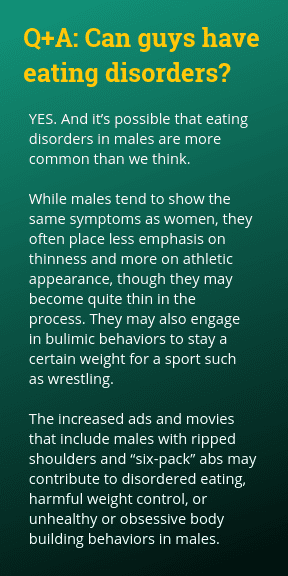What is Bulimia?

Posted in: Parenting Concerns, Teenagers, Young Adults
Topics: Mental Illness + Psychiatric Disorders
For more information about eating disorders and ways you can help make a difference for a young person in your life, or for yourself, please visit NEDA the National Eating Disorder Association website. #NEDAwareness
***
Christine never worried too much about her weight until age 18 when she arrived at college and started putting on the “freshman fifteen.” She was having lots of fun at school – drinking beer at parties and eating pizza and munchies late at night – but within 5 months she had gained a solid 15 pounds. She tried dieting and exercising but because she continued to eat large amounts of food, especially late at night, she couldn’t lose any weight until she started forcing herself to vomit. This didn’t help Christine diminish in size, but she felt she could at least maintain her weight this way, despite eating enormous amounts of chips, candies, cake, and pizza. Christine felt ashamed of her behavior and by the end of her freshman year was depressed as well. Christine was referred to an eating disorders clinic where she became involved in group therapy and received medication to treat her depression.
Christine was diagnosed with bulimia. Bulimia often begins during the college years when the desire to be thin and attractive to the opposite sex becomes increasingly important. Christine exhibits all of the classic features of bulimia:
- Frequent episodes of binge eating, which is rapidly eating large amounts of food – larger amounts than most people would eat in a typical sitting (for example, a gallon of ice cream, 2 bags of cookies) – and a lack of being able to control of this type of eating
- Attempts to prevent weight gain after binging. These can include vomiting, using medications such as diuretics or laxatives, fasting, or excessively exercising.
- The binge eating followed by attempts to prevent weight gain occur two or more times a week, for at least three months
- A self-perception that is distorted in terms of body shape and weight
There are two types of bulimia: the purging type and the non-purging type. Christine was the purging type, in that she usually vomited (purged) or used laxatives to control her weight. In the non-purging type the usual behaviors used to control weight are fasting or excessive exercising. Most individuals diagnosed with bulimia (almost nine in 10) use self-induced vomiting.
A typical binge can be over 5,000 calories – and even much more than that. I’ve heard adolescents with bulimia admit to baking two dozen cinnamon rolls and eating every one. They may eat 2 pizzas followed by 2 pints of ice cream. This type of eating can be very costly – and some children and adolescents with bulimia will steal food.
Possible signs of bulimia include:
- Binge eating
- Frequent trips to bathroom, especially after a large meal or binge eating
- Mood problems such as depression, irritability, fatigue
- Dental problems, particularly erosion of the enamel and gum disease
- GastrointesChristinel problems such as constipation, bloating, diarrhea (from the use of laxatives), abdominal pain
- Frequent weigh fluctuation
- Secretive eating; dislikes eating in front of others
Individuals with bulimia tend to be very ashamed of their problem – much more so than anorexics. In fact, teens with bulimia tend to feel so badly about themselves after binging that they tend to hide their problem from their friends and family. For this reason,
binging is usually done in private; for example, when a roommate is gone for the night or the parents are already asleep. Most people with bulimia aren’t aware that they are already full, and they’ll continue to eat until they are “found out,” they fall asleep, have stomach pain, or induce vomiting. Sometimes inducing vomiting will allow them to continue to binge. After a binge, most people experience feelings of guilt and sadness.
Bulimia is a very serious disorder, although most patients with bulimia who seek treatment make a complete recovery. It is less dangerous than anorexia (death is rare), but there are significant health problems associated with the disorder. These can include:
- edema (swelling of the hands and feet)
- stomach pains
- dental problems due to loss of enamel
- menstrual irregularities
- dehydration
- heart problems
It may surprise you to hear that many individuals with binge-eating problems are overweight and sometimes obese. Even though they try to control their weight through purging and the use of laxatives, the amount of calories they take in is so high that they gain weight in spite of their efforts to the contrary.
Because eating disorders are complex – and are caused by multiple factors – treatments need to address multiple influences. The major treatments for eating disorders include Family Therapy, Cognitive Behavior Therapy, Interpersonal Psychotherapy, and Medication. Group therapy is also often helpful. Read more about treating eating disorders here.
If you or a young person in your life is in need of help, and you are not sure where to begin, you can start searching for help and support through NEDA.


 Share
Share Tweet
Tweet





